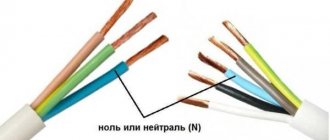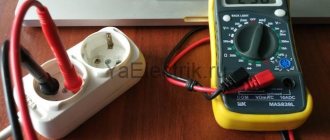Nowadays, PUE (electrical installation rules) provide for mandatory grounding of outlets in private and apartment buildings. But it was not always so. In older houses and most private sectors, a two-wire system is still used - phase and neutral. To be precise, a considerable number of electrical appliances do not require a grounding contact. Usually these are various lamps in a plastic case, televisions, and musical equipment. If the distribution board does not have a corresponding busbar or one of the listed household appliances needs to be connected to the network, you can use sockets without grounding, the cost of which is much lower. We will talk about them.
Electric networks yesterday and today
During the Soviet era, houses were built at an accelerated pace; there was not enough time to think through and arrange grounding. Moreover, such protection was useless - none of the household electrical appliances had a corresponding contact on the plug. The maximum that one could count on when moving to a new home was double sockets without grounding, which pleased with the possibility of connecting additional electrical appliances to the network.
Now everything has changed, and it has become quite difficult to find large household appliances in stores without a grounding contact. The sockets also acquired a new look, in which an additional bracket appeared, and the contact holes began to be covered with internal curtains to protect them from children. But although the usual connection points have not disappeared anywhere, they can be seen much less often. Outdoor sockets with a high IP protection class are usually installed without grounding.
Useful video on the topic
A lot of interesting information is in the video.
Leave a comment Cancel reply
Related Posts
Height and placement of sockets in the kitchen in a modern apartment
German ABB sockets combine reliability and stylish design
Connecting a double socket into one socket box How to connect a Lezard pass-through switch and what circuit to use.
Sockets with curtains: what are they for?
Such products are perfectly protected from children's curiosity. Curtains are special partitions inside the housing that block access to live contacts. In order to insert the plug into it, you need to make some effort. A little curious discoverer will not be able to stick any foreign body into it - a nail or a knitting needle. This allows parents to be calmer. Previously, special plastic plugs were used for such purposes, which were quite easily removed by the child.
Another type of such protection, although simpler, is a cover that is pressed against the body by a spring. Such products are more often used for outdoor installation, and therefore they do not have a wide range of colors. Mainly produced are gray and white external sockets without curtains with or without grounding, equipped with covers.
Stages of self-grounding
If a TN-CS circuit was used for electrical communications, you can ground the outlets yourself by following the following sequence of actions:
- De-energize the apartment - unscrew all the plugs or turn off the automatic plugs or slide-type automatic plugs.
- Clear access to the wiring - remove plaster or other finishing materials in the necessary places.
- Remove the necessary sockets.
- Connect the stripped ends of the conductors to the special contacts that are available in Eurostandard sockets.
- Connect all terminals to grounded sockets.
- De-energize the riser or house.
- Connect the conducted grounding to the common grounding of the riser or phase.
- Turn on the electricity supply in the house and apartment.
What does the presence of a grounding contact affect?
To connect such an outlet, certain wiring is required. There should be 3 wires approaching the connection point - phase, neutral and a yellow-green ground wire. Such sockets, when installed correctly, provide additional safety for both household appliances and people. If the grounding is done properly, and all the necessary automation is installed in the distribution cabinet, you don’t have to worry about overloads, voltage surges, and even phase breakdown on the metal body of the household appliance.
Checking for grounding
Another frequently asked question, which we decided to answer in our article, is: how to check the grounding in an outlet. In general, this issue should be dealt with by specialized organizations, which, depending on the class of electrical installation, carry out periodic inspections.
After all, each class and type of electrical installation has its own limiting standards for the ground loop resistance. But for your peace of mind, you can do it yourself.
Option for checking protective grounding
- To do this, at your dacha or in your apartment, you need to create another grounding loop, in relation to which we will take measurements.
- To do this, we drive an iron pin into the ground to a depth of at least 50 cm. We firmly attach the wire to it.
- We lay this wire to the socket, the integrity of the grounding in which we are interested in, and, using a multimeter or better megohmmeter, we measure the insulation resistance.
- If this resistance does not exceed 30 Ohms, then your grounding meets the established standards.
What are the benefits of sockets without grounding?
The advantage of such products is their simplicity - the fewer components, the more reliable the mechanism. It is also worth noting the low cost of such sockets. Ease of connection will most likely play a decisive role for novice home craftsmen who are faced with this issue for the first time. However, it is necessary to understand that if the home power network provides a grounding wire, then it should not be ignored, much less cut off, as some do. Such contact at some point can save a life. Of course, it would be better if such a danger did not arise, but the Japanese (and these people are very smart) say this: “It makes sense to sharpen your sword all your life so that it can save your life just once.” A similar statement is true in the case of grounding.
How to properly connect an outlet in a dorm if the wiring is not grounded?
Good afternoon. I have a question about connecting the socket. Dormitory, wiring without grounding. The old socket became unusable, so I decided to replace it. And this is what I saw - there is a wire going to my socket from above, bare in the middle, and below there are two wires from the neighbor’s socket.
I understand that the neighbor's outlet was powered from mine, but in a strange way (1). I disconnected the upper wire into two separate ones (I cut it) and did it as in (2), the output is 220. But the question is whether I made a mistake in cutting this upper one.
In any case, then it is not clear how it even worked before the replacement.
Before this, somewhere in the common corridor there was a lost zero and the light bulbs were constantly burning out.
According to the indicator screwdriver, one lights up as a phase, the second does not. There are no other wires to connect.
Thank you. (I attach photo below)
Share on social networks
Comments and reviews (4)
Vladimir
You don’t know how to connect as it was. Your socket has failed, not the wiring. Judging by the description, your sockets are connected with a cable. After you “saw through” the wire, you got 4 ends in the socket box. 2 ends of the bitten wire must be clamped into one terminal of the socket, the remaining two into another, having first checked for the presence of opposite phases (this happens in dorms)
Gosha, the cunning electrician
The client mentioned that lamps often burn out... This made me think that other phases were originally used on the floor. Then everything got mixed up... So, with a periodic loss of zero, a potential greater than zero comes instead through some load from another phase, and a potential greater than 220-*230V is formed in the power circuit, which burns these light bulbs. The best thing is, you need to call a competent specialist. And don’t limit yourself to one cell!
In a dorm you need to connect it correctly, but in a non-dorm how will you do it?
Let's summarize what has been said
Sockets without grounding have a right to exist, but only if there is no circuit. This applies to old houses and private sectors. If there is a third, yellow-green wire in the home power network, you should not ignore it. It is better to purchase and connect an outlet equipped with a grounding bracket. You should not assume that you plan to connect equipment whose plug is not equipped with the appropriate contact - everything can change. After all, it makes no sense to redo it several times when you can mount something that is suitable for powering any household appliance.
Hazardous work practices
When grounding, you should not resort to simplified methods of this type of protection:
- using a grounding wire;
- grounding through heating system pipes.
In the first case, if all electrical appliances are working properly, the neutral conductor is ready to act as a grounding conductor.
It is worth remembering the purpose of the residual current device.
Grounding is a protection system when any current leakage is converted into a short circuit and triggers a differential circuit breaker or RCD.
If the design is in good working order, the owner of the electrical appliance will, at best, receive a tripping of the protective element due to a short circuit. However, if the grounding wire is damaged in any way, the phase voltage (220 V) will appear on the housing.
In the second case, the pipeline system will work until part of the pipe in one of the apartments in an apartment building is replaced with plastic analogues. Due to the fall out of the metal part of the heating system, the supplied current will endanger both you and your immediate neighbors.
Under no circumstances should gas pipes be used to organize a protective grounding system. Because the electrical potential on the surface can lead to destructive consequences.
To ensure electrical safety, outlets in the house must be connected to a grounding circuit. When organizing such a protection system, you should avoid common mistakes, and entrust the installation of the circuit to an experienced electrician.
The essence of grounding and its significance
Electric current moves between two points, which differ from each other by different electric potential and electric charge. To start the flow of current, you need to connect two points. This can be done using copper wire.
In an electrical outlet, one socket has a charge of 220 V, and the other - 0. When the device is turned on, these two points are connected, which sets the current in motion. Only under this condition will electrical appliances function.
Each socket has 3 holes: neutral, ground and phase. The ground is connected to the wire directed to the screw type terminal. This wire performs the following functions:
- Guarantees safety from electric shock. If there is a current leak, the supply is immediately stopped.
- Ensures stable operation of the automatic shutdown system.
- Responsible for the correct operation of network filters, which are part of the designs of imported rubble equipment.
Grounding according to functionality can be divided into the following types:
- All parts of the equipment body that are electrically conductive are connected to zero. This type of grounding is known as grounding. When a phase gets on the housing, a short circuit occurs, which leads to the automatic safety system being knocked out.
- If there is a ground loop, all parts of the equipment that have the ability to conduct electric current are connected to it. The result of using this type of grounding is that in the event of current flow, the circuit receives the same voltage as the equipment frame.
The disadvantage of the automatic grounding system is its low response speed. The earth absorbs electrical current much faster, putting human life at risk.
Basic rules for connecting a grounded outlet
If a double or triple socket is installed in one socket in the wall, then you need to connect special jumper terminals between the devices. Do not tighten the bolts on the wires with the terminals too tightly, as the wire may break. After securing all the contacts, the socket is inserted into the hole in the wall and fixed in a stationary state using special stopper claws.
In this case, there are two ways out of the situation: installation by energy supply and organizations of additional grounding of the neutral wire or the use of RCDs, which are placed on the electrical circuit that powers powerful household appliances. When installing additional grounding in an apartment, it is necessary to change all the wiring in order to provide grounding to all sockets.
If an RCD is used, then most of all it is placed on the most energy-intensive lines: sockets to which devices that consume high power are connected. Of course, the RCD will not protect against electric shock in the event of a breakdown, but it will prevent fatal injury.
What kind of lighting do you prefer?
Built-in Chandelier
How to connect a grounded outlet - simple installation recommendations
It is necessary to begin work by de-energizing the room. To do this, the levers on the electrical panel are lowered to the lower position.
Expert opinion
Viktor Pavlovich Strebizh, lighting and electrical expert
Any questions ask me, I will help!
Along it, each wire that comes out of the panel is connected to 2 wires from additional cores, which are sent to sockets 2 and 3. If there is something you don’t understand, write to me!
Operating principle of protective grounding
To correctly understand the purpose and principle of operation of a grounded socket, you should take a closer look at its connection diagram.
Installing sockets with grounding allows you to ensure a connection between the metal casing of the electrical installation and the grounding circuit. Under normal operating conditions, such a connection does not in any way affect the operation of the electrical network elements; its operational characteristics remain the same as when using an outlet without grounding. However, if the insulation is damaged, grounding ensures that there is no high potential on the housing relative to ground. It also prevents the build-up of static electricity. This is achieved due to the presence of a wired connection with low active resistance between the metal parts of the case and the ground. In this case, when a person touches a grounded electrical installation, electric shock will not occur, since the skin resistance is many times higher than the resistance of the ground loop.
USEFUL INFORMATION: Wi-Fi router into an outlet: repeaters, repeaters
Grounding in a private house
For private houses, there are two connection options - two-phase and three-phase. If a three-phase profile is laid, there are no problems, you just need to check how the sockets work.
When the wiring is done using a two-phase wire, grounding can be done in the yard. You need:
- Choose a damp spot in the yard.
- Dig a small triangular trench.
- Drive metal pins into the corners, leaving 10 cm out.
- Weld a metal bar onto the pins.
- Weld the bolt.
- Use a nut to attach the cable to the bolt.
- Tighten the nut with a wrench.
- Cover the contour with earth.
- After this, lead the wire into the house to the meter.
- Make wiring from the meter to the sockets.
Important! Do not forget that the ground wire must be connected to the ground bus.
Expert opinion
Viktor Pavlovich Strebizh, lighting and electrical expert
Any questions ask me, I will help!
If you plan to install hidden sockets, you will need to prepare a hole of a suitable size, in the center of which the wire will be located. If there is something you don’t understand, write to me!











